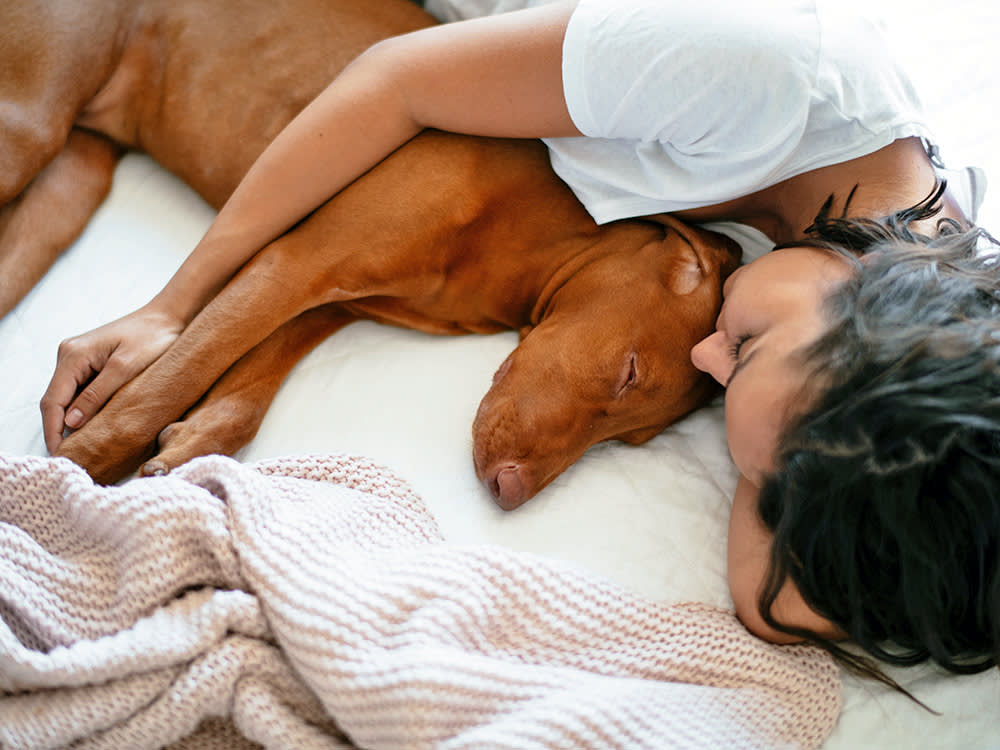Can Dogs Have Bad Dreams or Nightmares?
Or is this something you only think is happening?
In This Article:
Signs of Canine Nightmares Why Do Dogs Have Nightmares? When to Worry About Nightmares How to Cure Dog Nightmares Do Dogs Dream Like Humans?
Have you ever been woken up by your dog whining or growling in their sleep? Aww, they’re dreaming, you think. Or are you just projecting human-like qualities onto your sleeping angel? In this case, your dog is acting like a human: They definitely can dream.
And just like humans, there are optimal levels of sleep for your dog. Their REM sleep patterns can actually have an emotional and behavioral impact on them. Just like too much or too little sleep can put a toddler into a terrorizing mode, the same can be said for your pup. In this July 2022 studyopens in new tab, researchers found that dogs who receive less than eight hours and more than 10 hours of sleep had increased behavior problems.
Signs of canine nightmares
Just like humans, dogs exhibit dream-like behaviors, such as muffled barks, whimpers, twitching paws, or thrashing movements. They might also be twitching or crying.
How much do you spend on your pet per year?
Why do dogs have nightmares?
Again, it’s hard to tell if your dog is having a nightmare, but if you see them exhibiting the signs of distress listed above, that could be the case. If you think your dog is having a nightmare, they may have one of the following conditions:
Canine narcolepsy: Your dog may lose muscular tone before eating or playing or have frequent sleep attacks.
Sleep-disordered breathing: This happens if your dog will be a heavy snorer. They could also have a drop in their oxygen levels. This condition typically affects brachycephalic breeds.
REM sleep behavior disorder: This is when when your dog displays violent motor activities when sleeping: violent limb movement, howling, growling, or biting.
Is it a dream or is my dog having a seizure?
There are two types of seizures in dogs: generalized and focal. A generalized seizure is when the dog loses consciousness and shows stiffening or paddling of the body. During a focal seizure, the dog may or may not lose consciousness and will display consistent abnormal movements in one body part. If you think your dog had a seizure, contact your vet immediately. Make sure you have the number of an emergency vet on hand in case of instances like this.
Do dogs dream like humans?
Yes, dogs do have dreams just like we do. They’re probably not having complex work-stress dreams (lucky them; their only job is to be your little baby). But if you see them moving their legs, as if in a running motion, they are likely dreaming about whatever it is they did that day, like playing fetch on the beach or playing with a pal.
How to cure dog nightmares
Creating a safe space for your dog to sleep or rest is key in helping them get restful, uninterrupted sleep. Setting up a crate or bed in a quiet area can be helpful. Dogs do well with routines, so if there is a change in your life, try to keep things as similar as possible so your pup receives optimal snooze time.
When to worry about nightmares
If you notice your pup is having consistently violent episodes while sleeping or has difficulty waking up, it may be worth talking to your vet about one of the previously mentioned health concerns (canine narcolepsy, sleep-disordered breathing, or REM sleep behavior disorder). Again, if you think your dog had a seizure, do not hesitate to contact your vet and get your dog seen immediately.
It can be best to avoid suddenly waking a sleeping dog, regardless of whether they are dreaming or having a nightmare. If a dog is startled awake, they may choose to react negatively. While the content of their nightmares remains a mystery, researchers confirm dogs display neurological patterns and physical signs consistent with bad dreams.
References:
Sleep Characteristics in Dogs; Effect on Caregiver-Reported Problem Behavioursopens in new tab
Sleep in the Dog: Comparative, Behavioral and Translational Relevance
opens in new tab










